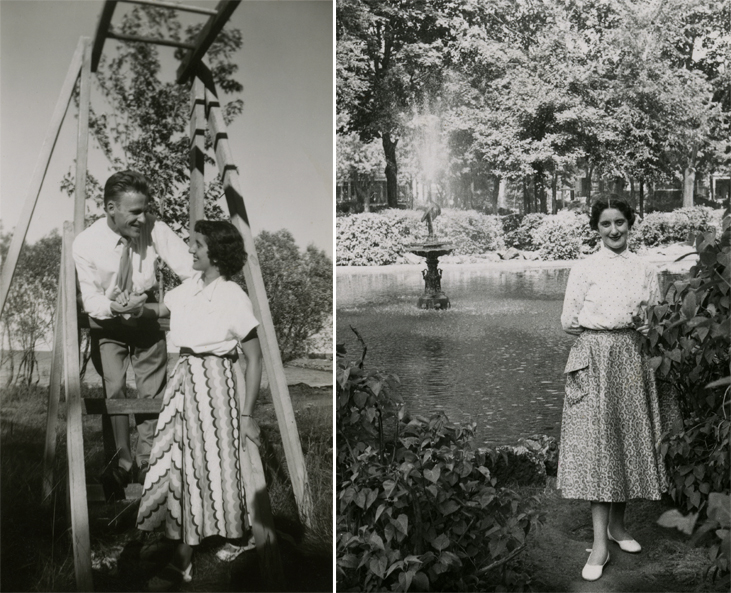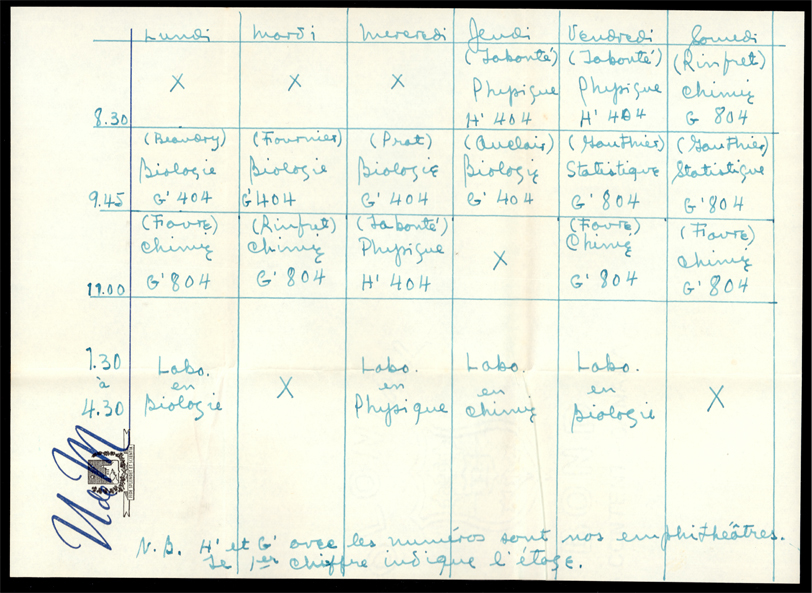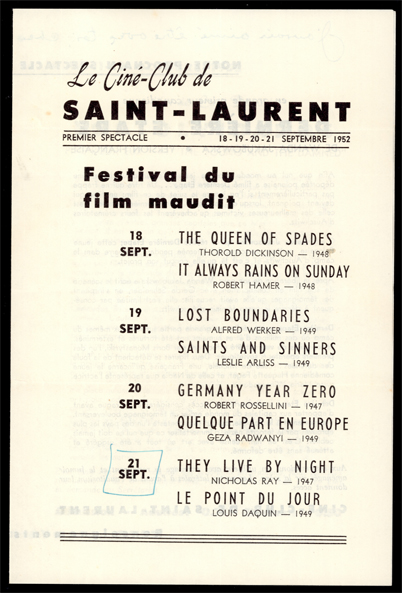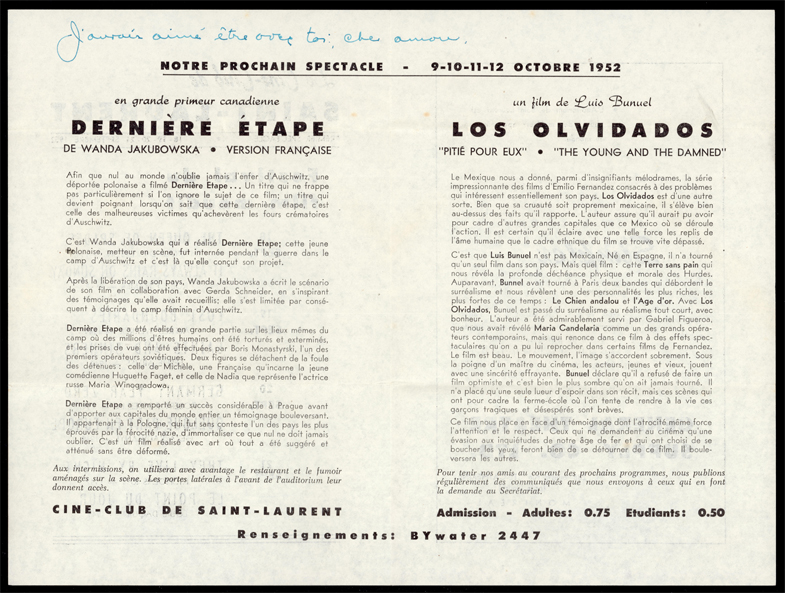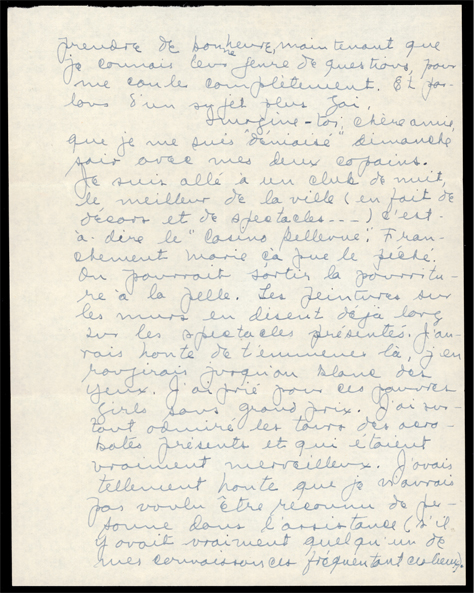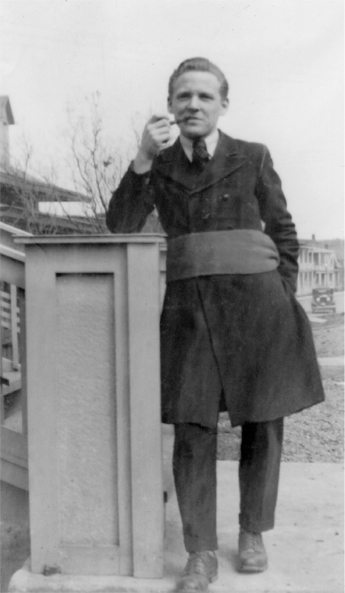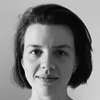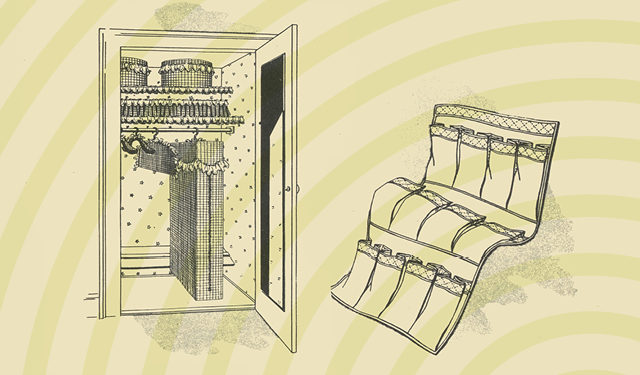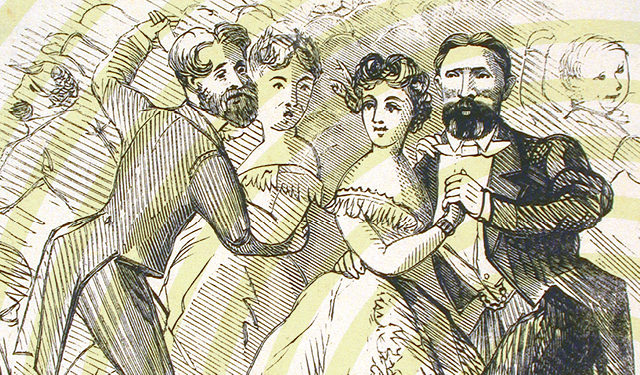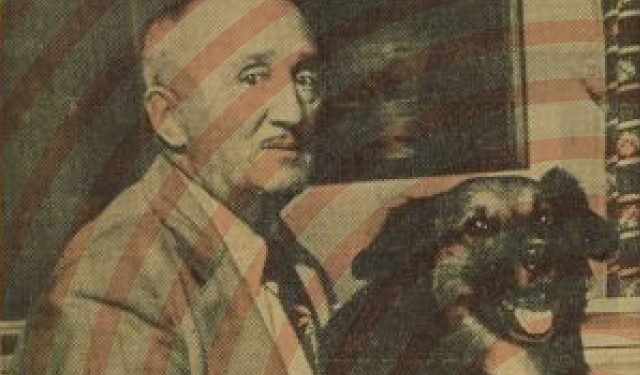Starting university, 1952
University student Jérémie Tremblay describes in his letters his life at school and in Montreal in the era preceding the Quiet Revolution.
September 15, 2021
This series of 12 articles written for the Shared Emotions project uncovers feelings, sensations and values buried in archival documents and looks at how they are shaped by the cultural and historical context of the time.
______
“Today is Tuesday, and I’m already getting tired of the noise from the trams on St. Denis Street. We’ve rented two ‘tourist’ rooms near Fernand’s place, but I have to admit that the trams aren’t the only thing bothering me! Despite all the work I need to do, and the class notes to review, I have to fight the urge to go back home with my parents tomorrow morning. I’m a weary man, but I’m also a student, who just wants to finish his degree. I guess it’s pretty easy to figure out who will prevail…”
September 9th, 1952 (P757/A2,3)
For many students, starting university brings new independence along with a heady mix of excitement and anxiety. In 1952, Jérémie Tremblay experienced this when he left Jonquière to begin a science degree at Université de Montréal. His plan was to major in biology and then study dental surgery. During his four years of study, he wrote numerous letters to his girlfriend and future wife, Mariette Bergeron, back home in Saguenay, in which he shared his impressions of university life.
His missives contain detailed descriptions of his schedule, his subjects, and the formal atmosphere of his classes.
“When a professor makes his entrance—they are all very punctual—we all remain ‘respectfully’ seated in the auditorium, as if a fly had landed on the stage of a theatre. For his part, the professor ignores our presence and, without prayer, without further ado, grabs a piece of chalk and starts writing notes on large, portable blackboards that we hurriedly transcribe. When he speaks, we copy down every word, and he doesn’t even seem to notice: as you can see, he is a Great Master. When he leaves, we all applaud internally…”
September 13th, 1952 (P757/A2,3)
When Jérémie starts university, he also begins exploring urban life in Montreal and the city’s many diversions. A movie buff, he is a regular at Théâtre St-Denis and the Collège Saint‑Laurent film club. He also takes folk dancing classes and goes out on St. Catherine Street, where he has a chance to see Maurice Richard in action at the Forum and admire Eaton’s store windows, which display televisions, a fast-growing new technology at that time.
“I was going to sign off but I forgot to tell you that last Sunday evening, I made a youthful mistake, which brings my total to two. When I was out with Paul-Aimé (Boily), we went to the Alouette movie theatre to see Fanfan la Tulipe, starring Gérard Philippe. You should see it if it comes to Jonquière. When we left the theatre at 8:30 pm, we strolled down St. Catherine Street to see what was on display in the department store windows, which was very entertaining. We even saw a TV playing in the Eaton’s window. We got home at 10 pm, after I had spent another 95 cents.”
September 17th, 1952 (P757/A2,3)
On several rare, more daring, outings, Jérémie was exposed to what he considered questionable morals, notably during an evening at the Bellevue Casino, a nightclub that made a very bad impression on him: “Honestly, Marie[,] the place reeked of sin. It was absolutely teeming with decadence.” (November 11th, 1952 ; P757/A2,3).
STUDYING AT UNIVERSITY PRIOR TO THE PARENT REFORM
After the Second World War, Université de Montréal remained an officially Catholic institution, a fact reflected in its principles, rituals, and administration1. Although it received a civil charter in 1920, it operated under the authority of the archdiocese of Montreal until 19672. Jérémie illustrates this connection in one of his letters to Mariette, when he tells her about the annual University Mass, a symbol of the continued strong presence of religion in higher education in the 1950s3.
“Today[,] we had the whole day off. We went to an official University Mass at 10 am, held at the Saint-Germain-d’Outremont church. All the professors, from every science, wore their doctor’s gowns and mortarboards of various colours. It is the University’s only official act as a Catholic institution each year.”
September 30th, 1952 (P757/A2,3)
Jérémie’s letters reveal the Church’s omnipresence in Quebec until the Quiet Revolution, including its presence in Université de Montréal’s faculties of science, where many classes were taught by priests. Driven by great piety, Jérémie took part in meetings of the Cercle Lacordaire, a Catholic temperance group that preached total abstinence from alcohol, and attended the daily Mass celebrated in the University’s chapel.
“To make it easier for students to attend Mass, every day at noon, after class, Mass is celebrated in the University’s little chapel, in a unique, captivating atmosphere. There is a five-minute gem of a sermon, always about the gospel of the day, but adapted especially for students. […] I would say at least fifty or more students, male and female, attend.”
September 17th, 1952 (P757/A2,3)
Despite the ecclesiastical administration and Masses offered by Université de Montréal, on more than one occasion Jérémie was shocked by what he considered the institution’s lack of piety. For instance, no prayers were said before class, possibly an indication of the erosion in religious values that became more pronounced in the following decades. In fact, although the young man’s great religious devotion illustrates the pervasiveness of Catholicism in 1950s Quebec, his letters also reveal the beginnings of a cultural effervescence that would explode several years later with the advent of the Quiet Revolution. For example, Jérémie’s mention of “several young women” in his science classes illustrates the growing presence of women in academia, as well as their increased contributions to the economy in the 1950s4. Several of the young man’s critical comments also reflect a wide variation in the degree to which students lived by their religion in the period leading up to the secularist movement of the Quiet Revolution, in addition to perhaps highlighting the contrast between Jérémie’s small-town origins and the more liberal atmosphere of the big city.
“In a place like the University, anyone who does not possess an intense inner flame is tempted by all sorts of tendencies, both good and bad. In my opinion, students here either embrace their Catholicism or they do not. There is no middle ground. I can assure you that while some guys at the University are great, the inverse is also true. Sometimes, just a word or prayer does more good than a long speech.”
September 17th, 1952 (P757/A2,3)
In the field of education, the Quiet Revolution resulted in a profound transformation of academic institutions following the implementation of recommendations from the Parent Commission. A decade after Jérémie’s arrival at Université de Montréal, this sequence of reforms launched by the Lesage government made higher education available to more people, notably French speakers, who, up to that time, were under-represented in the province’s universities5.
Since then, the democratization of higher education has enabled an impressive number of people from a variety of backgrounds to experience the same liberating exhilaration of starting university felt by Jérémie Tremblay in 1952. The question now is, what will the back-to-school ritual be like in 2021? Nearly 60 years after the Parent report, some critics are condemning a decline in access to education, pointing to the increase in special programs in public schools and unequal access to technology6. In addition, these inequalities may well have been exacerbated by distance learning and other impacts of the COVID-19 pandemic. It is hard to know what lies in store for those starting university this year. Will they too have the opportunity to feel that excitement of discovery and uncertainty, fear, and new encounters ?
TO LEARN MORE
- To read the young lovers’ correspondence and learn more on the Jérémie Tremblay and Mariette Bergeron Fonds (P757)
- To learn more on the Shared Emotions project
- To learn more on the Textual Archives Collection
NOTES
1. Jean-Luc Ratel, with Philippe Verreault-Julien, Le financement des universités québécoises : histoire, enjeux et défis, Quebec City: Confédération des associations d’étudiants et d’étudiantes de l’Université Laval, 2006, p. 14.
2. Michel Champagne, Les documents fondateurs de l’Université de Montréal, Service de la gestion des documents et des archives de l’Université de Montréal, p. 10.
3. Claude Corbo, with Jean-Pierre Couture, Repenser l’école. Une anthologie des débats sur l’éducation au Québec de 1945 au rapport Parent, Montreal: Presses de l’Université de Montréal, 2000, p. 220.
4. Denyse Baillargeon, Brève histoire des femmes au Québec, Montreal: Boréal, 2012, p. 166.
5. Andrée Dufour, “Les années 1950 : une décennie annonciatrice de grands changements,” Bulletin d’histoire politique, vol. 12, no. 2, p. 18.
6. Caroline Plante, “Une commission Parent 2.0?” Le Soleil, June 9, 2019 ; Radio-Canada, “Programmes particuliers : les écoles publiques de plus en plus sélectives“, October 24, 2019 ; Camille Feireisen, “L’école à distance exacerbe les inégalités entre les enfants“, Radio-Canada, May 18, 2020.
REFERENCES
BAILLARGEON, Denyse, Brève histoire des femmes au Québec, Montréal, Boréal, 2012, 281 p.
CHAMPAGNE, Michel. Les documents fondateurs de l’Université de Montréal, Service de la gestion des documents et des archives de l’Université de Montréal.
CORBO, Claude, with Jean-Pierre COUTURE, Repenser l’école. Une anthologie des débats sur l’éducation au Québec de 1945 au rapport Parent, Montreal: Presses de l’Université de Montréal, 2000, 667 p.
DUFOUR, Andrée, “Les années 1950 : une décennie annonciatrice de grands changements,” Bulletin d’histoire politique, vol. 12, no. 2, p. 16-23.
FEIREISEN, Camille, “L’école à distance exacerbe les inégalités entre les enfants“, Radio-Canada, May 18, 2020.
FERRETTI, Lucia, L’université en réseau. Les 25 ans de l’Université du Québec, Montreal: Les Presses de l’Université du Québec, 1994, 328 p.
LUCIER, Pierre, “L’université du Rapport Parent,” Bulletin d’histoire politique, vol. 12, no. 2, p. 81-94.
PLANTE, Caroline, “Une commission Parent 2.0?” Le Soleil, June 9, 2019.
Radio-Canada, “Programmes particuliers : les écoles publiques de plus en plus sélectives“, October 24, 2019.
RATEL, Jean-Luc, with Philippe VERREAULT-JULIEN, Le financement des universités québécoises : histoire, enjeux et défis, Quebec City: Confédération des associations d’étudiants et d’étudiantes de l’Université Laval, 2006, 146 p.
THANK YOU!
This project has been made possible in part by the financial support of Library and Archives Canada.



